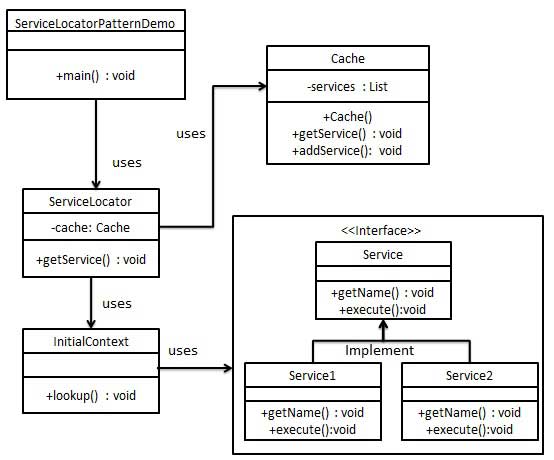设计模式【服务器定位模式Service Locator Pattern】
来源:互联网 发布:sql数据库设计 编辑:程序博客网 时间:2024/06/11 00:15
服务定位器模式
服务定位器模式(Service Locator Pattern)用在我们想使用 JNDI 查询定位各种服务的时候。考虑到为某个服务查找 JNDI 的代价很高,服务定位器模式充分利用了缓存技术。在首次请求某个服务时,服务定位器在 JNDI 中查找服务,并缓存该服务对象。当再次请求相同的服务时,服务定位器会在它的缓存中查找,这样可以在很大程度上提高应用程序的性能。以下是这种设计模式的实体。
- 服务(Service) - 实际处理请求的服务。对这种服务的引用可以在 JNDI 服务器中查找到。
- Context / 初始的 Context - JNDI Context 带有对要查找的服务的引用。
- 服务定位器(Service Locator) - 服务定位器是通过 JNDI 查找和缓存服务来获取服务的单点接触。
- 缓存(Cache) - 缓存存储服务的引用,以便复用它们。
- 客户端(Client) - Client 是通过 ServiceLocator 调用服务的对象。
实现
我们将创建 ServiceLocator、InitialContext、Cache、Service 作为表示实体的各种对象。Service1 和 Service2 表示实体服务。
ServiceLocatorPatternDemo,我们的演示类在这里是作为一个客户端,将使用 ServiceLocator 来演示服务定位器设计模式。

步骤 1-创建服务接口Service
Service.cs
namespace ServiceLocatorPattern{ interface Service { string getName(); void execute(); }}步骤 2-创建实体服务
Service1.cs
using System;namespace ServiceLocatorPattern{ class Service1 : Service { public string getName() { return "Service1"; } public void execute() { Console.WriteLine("Executing Service1"); } }}Service2.cs
using System;namespace ServiceLocatorPattern{ class Service2 : Service { public string getName() { return "Service2"; } public void execute() { Console.WriteLine("Executing Service2"); } }}步骤 3-创建查询功能的InitialContext
InitialContext.cs
using System;namespace ServiceLocatorPattern{ class InitialContext { public object lookup(string jndiName) { if (jndiName.Equals("Service1")) { Console.WriteLine("Looking up and creating a new Service1 object"); return new Service1(); } else if (jndiName.Equals("Service2")) { Console.WriteLine("Looking up and creating a new Service2 object"); return new Service2(); } return null; } }}步骤 4-创建缓存Cache
Cache.cs
using System;using System.Collections.Generic;namespace ServiceLocatorPattern{ class Cache { private List<Service> services; public Cache() { services = new List<Service>(); } public Service getServices(string serviceName) { foreach (var service in services) { if (service.getName().Equals(serviceName)) { Console.WriteLine("Returning cached " + serviceName + "object"); return service; } } return null; } public void addService(Service newService) { if (!services.Contains(newService)) { services.Add(newService); } } }}步骤 5-创建服务定位器
ServiceLocator.cs
namespace ServiceLocatorPattern{ class ServiceLocator { private static Cache cache = new Cache(); public static Service getService(string jndiName) { Service service = cache.getServices(jndiName); if (service != null) return service; InitialContext context = new InitialContext(); Service service1 = (Service)context.lookup(jndiName); cache.addService(service1); return service1; } }}步骤 6-使用ServiceLocator来演示
ServiceLocatorPatternDemo.cs
using System;namespace ServiceLocatorPattern{ class ServiceLocatorPatternDemo { static void Main(string[] args) { Service service = ServiceLocator.getService("Service1"); service.execute(); service = ServiceLocator.getService("Service2"); service.execute(); service = ServiceLocator.getService("Service1"); service.execute(); service = ServiceLocator.getService("Service2"); service.execute(); Console.Read(); } }}步骤 7-验证输出
Looking up and creating a new Service1 objectExecuting Service1Looking up and creating a new Service2 objectExecuting Service2Returning cached Service1 objectExecuting Service1Returning cached Service2 objectExecuting Service2
阅读全文
0 0
- 设计模式【服务器定位模式Service Locator Pattern】
- Java Service Locator Pattern(服务器定位模式)
- 设计模式学习—服务定位模式(Service Locator Design Pattern)
- 【设计模式】服务定位器模式(Service Locator Pattern)
- 服务定位器模式(service locator)
- Service Locator 模式 的学习
- Service Locator Pattern
- Service Locator Design Pattern
- 服务定位器模式(Service Locator Pattern)详解和代码示范
- [Design Pattern] Service Locator Pattern
- 用SERVICE LOCATOR 模式实现命名访问
- 用SERVICE LOCATOR 模式实现命名访问
- java设计模式进阶_service-locator
- 用SERVICE LOCATOR 模式实现访问命名服务
- 用SERVICE LOCATOR 模式实现访问命名服务
- 设计模式-----(Factory pattern)
- Design pattern设计模式
- Design Pattern, 设计模式
- mongo eval方法执行需要认证解决办法
- C#中System.String类
- 我的物联网项目(十四) 分布式事务
- Centos7 安装 PHP7最新版的详细教程
- 测试在vue下点击事件传参和不传参的区别
- 设计模式【服务器定位模式Service Locator Pattern】
- 6.1 使用接口
- 007-100-判断两个二叉树是否相等 Same Tree
- k近邻法
- unity 安卓 如何读取 Application.persistentDataPath这个路径下面的assetbundle文件
- C语言学习内容总结2017/11/18(malloc函数)
- cmake opencv 路径问题
- 桥接模式
- centos7 安装apache+php


